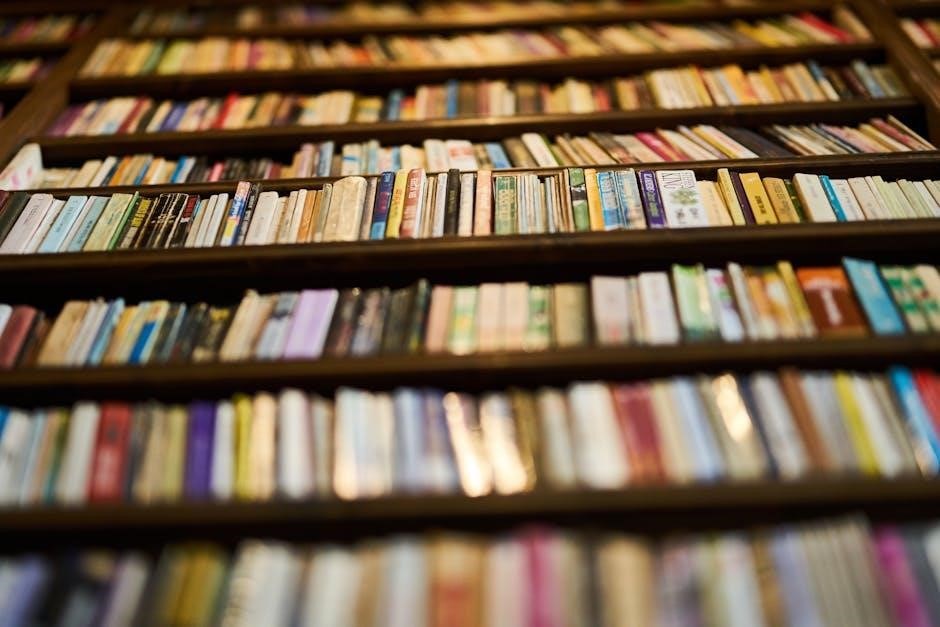Don Quixote, a foundational work of Western literature, is Miguel de Cervantes’ timeless tale of a nobleman obsessed with chivalric romances, embarking on absurd adventures with his squire, Sancho Panza.
Brief Overview
Don Quixote, written by Miguel de Cervantes, is a timeless tale of a nobleman who becomes obsessed with chivalric romances, leading him to embark on absurd adventures. Accompanied by his pragmatic squire, Sancho Panza, Don Quixote deludes himself into believing he is a knight-errant, seeking to revive chivalry and justice. His misadventures, such as attacking windmills and engaging in humorous misinterpretations of reality, highlight the clash between imagination and reality. This groundbreaking novel, often regarded as the first modern novel, explores themes of madness, societal satire, and the human condition. Available in PDF, ePub, and Kindle formats, it remains a cornerstone of world literature, offering a profound and enduring commentary on human nature and society.
Historical Context
Don Quixote, published in two parts (1605 and 1615), is set against the backdrop of a Spain transitioning from a feudal to a modern society. The novel reflects the decline of chivalry and the rise of individualism, critiquing romantic ideals of the past. Cervantes, influenced by his own experiences as a soldier and prisoner, crafted a narrative that satirizes the societal shifts of his time. The early 17th century was marked by economic and cultural changes, which the novel mirrors through its exploration of reality vs. imagination. This historical context underscores the novel’s role as a precursor to modern literature, offering a timeless critique of societal norms and human folly.
Background of the Novel
Don Quixote, written by Miguel de Cervantes, is a seminal work in world literature, blending humor and philosophy to explore themes of reality and imagination, leaving a lasting cultural impact;
Author’s Inspiration
Miguel de Cervantes drew inspiration from his own life experiences, including his military service, imprisonment, and observations of Spanish society. He aimed to critique romantic chivalric tales while exploring human nature through Don Quixote’s delusions and Sancho Panza’s pragmatism. Cervantes’ innovative storytelling reflected his desire to break from traditional literary norms, blending humor, philosophy, and social commentary. His work was deeply influenced by the cultural and historical context of 17th-century Spain, creating a timeless narrative that continues to resonate with readers globally.
Publication History
Don Quixote was published in two parts, with the first volume appearing in 1605 and the second in 1615. The novel gained immediate popularity, prompting the publication of the sequel. Over time, it has been digitized by Google from the New York Public Library and uploaded to the Internet Archive. Today, it is widely available for free download in formats such as PDF, EPUB, and MOBI, making it accessible to readers worldwide. Its enduring popularity has ensured its presence in various editions and translations, solidifying its place as a literary classic.

Plot Overview
Don Quixote’s obsession with chivalric tales leads him to embark on absurd adventures with Sancho Panza, blending reality, imagination, and the decline of knight-errantry.
Main Plot
Don Quixote, an aging nobleman consumed by tales of chivalry, renounces reality to become a self-proclaimed knight-errant. Accompanied by his practical squire, Sancho Panza, he embarks on a series of comedic misadventures. Believing windmills are giants and peasants are royalty, his imagination distorts reality, leading to humorous and poignant encounters. His quest to revive chivalry and seek glory reflects the decline of knightly ideals in a changing world. The novel explores themes of delusion, reality, and the human condition, blending humor with deeper philosophical insights, making it a timeless masterpiece of literature. Available in PDF, it remains a cornerstone of the Western literary canon.
Subplots
Don Quixote’s adventures are enriched by numerous subplots that add depth and complexity to the narrative. One notable subplot involves the tale of the farmer and his daughter, Marcela, whose tragic story intersects with Don Quixote’s delusions. Another subplot follows the escapades of the Duke and Duchess, who play along with Don Quixote’s fantasies, creating a series of humorous and satirical situations. These secondary storylines not only provide comic relief but also explore themes of love, deception, and societal norms; They complement the main plot by showcasing the broader social and cultural context of 17th-century Spain. The interplay of these subplots highlights Cervantes’ mastery of storytelling and his ability to weave multiple narratives into a cohesive whole. The novel is available in PDF format for readers to explore these intricate layers.
Themes in Don Quixote
Don Quixote explores themes of reality vs. imagination, chivalry, and social satire, critiquing the romantic ideals of knight-errantry and the societal norms of 17th-century Spain.
Reality vs. Imagination
Don Quixote’s perception of reality is deeply intertwined with his imagination, as he envisions himself as a knight-errant, blurring the lines between fantasy and the real world. His obsession with chivalric romances leads him to interpret ordinary events as extraordinary, such as mistaking windmills for giants. This theme highlights the human tendency to escape into idealized fantasies, often at the cost of practicality. Through Don Quixote’s delusions, Cervantes critiques the romantic ideals of his time, while also exploring the tragic consequences of an aging man’s refusal to accept the world as it is. This tension between reality and imagination remains a central focus of the novel.
Chivalry and Knight-Errantry
Don Quixote’s devotion to chivalry and knight-errantry drives the narrative, as he aspires to revive a bygone era of honor and bravery. Inspired by romantic tales, he adopts the identity of a self-proclaimed knight, seeking glory and justice. His adherence to chivalric codes, such as dedicating his quests to Dulcinea, reflects the idealized values of medieval knighthood. However, his interpretations often lead to comedic misunderstandings, as reality fails to match his romanticized expectations. Cervantes uses this theme to satirize the decline of chivalry, illustrating the disparity between idealized notions of knight-errantry and the practical realities of 17th-century Spain. This exploration of chivalry’s ideals versus its practicality remains a pivotal element in the novel’s commentary on societal change.

Social Satire
Don Quixote serves as a sharp critique of 17th-century Spanish society, employing humor and irony to expose its flaws. Cervantes uses the protagonist’s delusional adventures to mock the romantic chivalric novels that shaped his imagination, while also highlighting the social and economic realities of the time. The character of Sancho Panza, with his practicality and earthy wisdom, contrasts Don Quixote’s idealism, symbolizing the clash between illusion and reality. The novel satirizes class distinctions, religious hypocrisy, and the decline of traditional values, offering a commentary on the human condition through its timeless themes. This blend of wit and insight has made Don Quixote a cornerstone of literary satire, influencing countless works that followed in its footsteps.

Major Characters
Don Quixote, a nobleman obsessed with chivalric tales, embarks on fantastical adventures with his loyal squire, Sancho Panza, who embodies practicality and grounded wisdom, contrasting his master’s delusions.
Don Quixote
Don Quixote, the protagonist of Miguel de Cervantes’ timeless novel, is a nobleman who becomes obsessed with chivalric romances. Renaming himself “The Ingenious Gentleman Don Quixote of La Mancha,” he embarks on a series of delusional adventures, imagining himself as a knights-errant. His obsession with these tales leads him to perceive reality through the lens of his imagination, famously mistaking windmills for giants and flocks of sheep for armies. Driven by a desire to revive chivalry and win the heart of his idealized lady, Dulcinea, Don Quixote’s journey is marked by both comedic misadventures and profound reflections on reality, sanity, and the human condition. His character remains one of the most iconic and complex in literary history.
Sancho Panza
Sancho Panza, the pragmatic and loyal squire of Don Quixote, serves as both a contrast and complement to his master’s idealistic delusions. A peasant driven by practicality, Sancho joins Don Quixote’s adventures in hopes of gaining wealth and status. His down-to-earth perspective often clashes with Don Quixote’s fantastical interpretations of reality, providing much of the novel’s comedic relief. Despite his skepticism, Sancho remains devoted to Don Quixote, embodying a deep-seated loyalty and humanity. His character represents the voice of reason in a world shaped by Don Quixote’s imagination, making him one of the most beloved and relatable figures in the novel. Sancho’s role highlights themes of friendship, realism, and the complexities of human nature.
PDF Downloads and Availability

Don Quixote is freely available in PDF, EPUB, and MOBI formats from sources like Project Gutenberg and the Internet Archive, ensuring easy access for readers worldwide.
Sources for Download
Don Quixote is widely available for free download from reputable sources like Project Gutenberg, the Internet Archive, and Google Books. These platforms offer the novel in multiple formats, including PDF, EPUB, and MOBI, compatible with various e-readers and devices. Additionally, sites like ManyBooks and Standard Ebooks provide meticulously formatted versions, ensuring a seamless reading experience. Users can also access the novel through libraries like the New York Public Library, digitized by Google. These sources are reliable and legally offer free downloads, making the classic accessible to readers worldwide without copyright restrictions in the public domain.
Formats and Editions
Don Quixote is available in various digital formats, including PDF, EPUB, MOBI, and AZW3, ensuring compatibility with e-readers, tablets, and smartphones. The novel can be downloaded in its original Spanish or translated into multiple languages, such as the renowned John Ormsby and Edith Grossman translations. Editions range from classic versions to modern adaptations, with some featuring annotations and introductions by scholars. The Internet Archive and Project Gutenberg offer the book in PDF with text and image-only scans, catering to different reader preferences. Additionally, specific editions like the Dover adaptation provide condensed versions of the original text, making it accessible to a broader audience while preserving the essence of Cervantes’ masterpiece.

The Significance of Don Quixote in Literary History
Don Quixote is celebrated as the first modern novel, pioneering narrative techniques and influencing Western literature profoundly, making it a cornerstone of the literary canon.
Impact on Western Literature
Don Quixote’s influence on Western literature is immense, as it pioneered the modern novel and reshaped narrative techniques. Its exploration of reality vs. imagination inspired countless writers, from Dickens to Faulkner. The novel’s satirical depth and complex characters set a new standard for literary craftsmanship, influencing genres like realism and romanticism. By challenging traditional storytelling, Cervantes laid the groundwork for psychological depth and moral complexity in fiction. Don Quixote’s legacy endures, making it a foundational text in the Western literary canon, continually studied and adapted across cultures and mediums, ensuring its timeless relevance and artistic impact.
First Modern Novel
Don Quixote is widely regarded as the first modern novel, marking a shift from medieval romances to realistic fiction. Its narrative structure, character development, and psychological depth broke new ground in literature. The novel introduced a relatable protagonist, blending humor with pathos, and explored themes like madness and reality. This innovative approach influenced future writers, establishing the novel as a dominant literary form. Available in formats like PDF, Don Quixote remains accessible, ensuring its ideas continue to resonate. Its impact on Western literature is undeniable, solidifying its place as a pioneering work in the evolution of the novel.

Symbolism and Motifs
Don Quixote richly employs symbols like the windmills, representing illusion vs. reality, and motifs such as chivalric quests, highlighting themes of madness, perception, and idealism.
The Use of the Windmills

The windmills in Don Quixote symbolize the clash between reality and imagination, as Don Quixote famously mistakes them for giants. This iconic episode highlights his delusional perception of the world, shaped by his obsession with chivalric tales. The windmills represent the mundane aspects of everyday life, which Quixote transforms into extraordinary challenges through his imagination. This motif underscores the novel’s exploration of madness, reality, and the human tendency to idealize the ordinary. The windmills have become a cultural symbol, often associated with Quixotic behavior, embodying the tension between illusion and reality that defines the novel’s core themes.
The Role of Dulcinea
Dulcinea del Toboso, the lady of Don Quixote’s affections, serves as the symbolic center of his chivalric delusions. Though she never appears directly, Dulcinea represents the idealized love and inspiration that drives Quixote’s quest. His devotion to her is rooted in the chivalric romances he obsessively reads, where ladies are revered as unattainable ideals. Dulcinea embodies the abstract notion of perfection and virtue, fueling Quixote’s imagination and justifying his absurd endeavors. Her role underscores the novel’s exploration of illusion versus reality, as Quixote’s perception of her remains untouched by the practical world around him. Dulcinea’s absence in the narrative highlights the power of idealism in shaping human behavior and aspirations.

Critical Reception and Analysis
Don Quixote is widely acclaimed as a literary masterpiece, praised for its profound exploration of reality, imagination, and human nature, influencing countless scholarly interpretations and literary studies.

Reviews and Ratings
Don Quixote has garnered universal acclaim, celebrated as a foundational work in world literature. Critics praise its nuanced exploration of human nature, blending humor and tragedy. Rated highly across literary circles, it is often cited as one of the greatest novels ever written. The book’s enduring popularity is evident in its widespread availability in formats like PDF, ePub, and Kindle, with free downloads from sources such as Project Gutenberg and the Internet Archive. Readers and scholars alike commend its timeless themes and innovative storytelling, solidifying its place as a cornerstone of Western literature. Its influence extends beyond academia, shaping art, culture, and media globally.
Scholarly Interpretations
Scholars widely regard Don Quixote as a profound exploration of reality, imagination, and human consciousness. The novel’s innovative narrative structure, blending humor and tragedy, has led to interpretations of Don Quixote as both a tragic figure and a symbol of idealism. His obsession with chivalric romances highlights the tension between illusion and reality, a theme central to modernist thought. The relationship between Don Quixote and Sancho Panza is often seen as a metaphor for the interplay between imagination and practicality. Scholarly analyses also emphasize the novel’s subversion of traditional literary norms, establishing it as a cornerstone of Western literature. Its open-ended narrative, noted by critics like Carlos Fuentes, invites readers to engage deeply with its themes. The availability of the novel in formats like PDF, ePUB, and Kindle has further facilitated its scholarly study and appreciation.
Cultural Impact
Don Quixote has profoundly shaped global culture, inspiring countless adaptations in film, art, and literature. Its iconic imagery, like the windmills and Dulcinea, is universally recognized, reflecting its enduring influence.
Adaptations in Media
Don Quixote has been adapted into numerous films, stage productions, and even an opera. The novel’s timeless themes and iconic characters, such as Don Quixote and Sancho Panza, have inspired filmmakers and artists worldwide. Notable adaptations include the 1972 ballet Don Quixote and the 1965 musical Man of La Mancha, which won a Tony Award. These adaptations highlight the enduring appeal of Cervantes’ masterpiece, ensuring its relevance across generations and mediums. The story’s universal themes of ambition, reality, and loyalty continue to captivate audiences, making it a cornerstone of global culture and entertainment.
Influence on Art and Literature
Don Quixote has profoundly shaped art and literature, inspiring countless works. Its exploration of reality versus imagination influenced writers like Dickens and Flaubert, while its satire and character depth set a new standard for novels. The book’s themes and motifs, such as the iconic windmills, have become cultural symbols. Many artists have illustrated the novel, capturing its essence in various styles. The character of Don Quixote himself has become a cultural icon, symbolizing both madness and idealism. As the first modern novel, Don Quixote continues to inspire authors, artists, and thinkers, solidifying its place as a foundational work in world literature and art. Its legacy endures, influencing new generations of creators.
